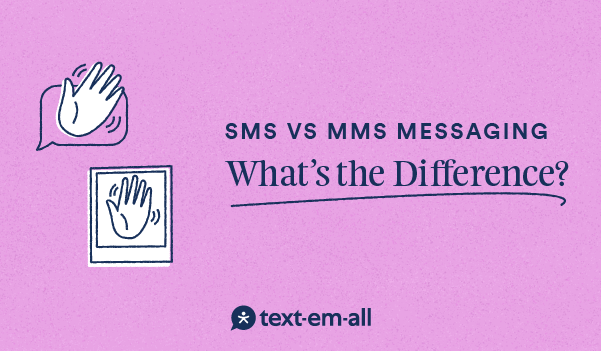
Mass texting continues to be an increasingly powerful tool for companies to connect with their contacts instantly, which is why it’s so important that businesses understand how to use it properly.
The two ways to send text messages are SMS and MMS, and each offers distinct advantages and capabilities when used the right way. In this article, we’ll explore the differences, use cases, and how they have transformed the way we communicate.
What is SMS messaging?
SMS messages are pure text and are limited to 160 alphanumeric characters per message, which is just a fancy word for both letters and numbers. In the U.S. alone, Americans send over 6 billion SMS messages daily.
What is MMS messaging?
MMS is the most popular option for sending multimedia content such as videos, pictures, GIFs, and audio files. Unlike SMS, these messages do not have a standard length.
Text-Em-All customers can send a .PNG or .JPG/.JPEG file up to 5 MB. This new feature is available in both "Create Broadcast" and "Inbox" for both our Pay-As-You-Go and Monthly customers.
*Explicit imagery is NEVER tolerated (nudity, partial nudity, cursing, etc.). Responsible Use Policy.
The Difference Between SMS & MMS
Primarily, SMS and MMS differ in a few main ways.
On the one hand, SMS messaging only supports text and links, while MMS messaging supports rich media such as images, GIFs, and video. Another difference is that SMS messaging limits texts to 160 characters, while image messaging can include up to 500 KB of data (1,600 words) and up to 30 seconds of audio or video.
Generally, SMS messaging is cheaper than the equivalent MMS message, though the final cost depends on your messaging provider.
Which is better?
While both messages allow you to reach your customers anytime, each protocol has different uses. That means which one you go with depends on the objectives of your campaign and what you're trying to send.
For example, if you have a smaller budget, you'll want to stick with SMS messaging. They're cheaper to send, meaning they scale better than MMS messaging so you can save more on those delivery costs. Informational messages are also better sent via SMS because the text should be all you need, though if you have a promotional offer, it may be better to consider an MMS message.
When deciding between MMS vs. SMS, ask these questions about your messaging goals and objectives.
- Are you interested in sending text-only or visual messages?
- Do your contacts engage and respond better with simple text messages or colorful imagery?
- Does the character count limit your content and communication goals?
When to use SMS
If you urgently need to send a sentence or two of information, you'll probably do better with an SMS. SMS messages have a 98 percent open rate, and any cell phone can receive an SMS.
Some of the best ways to use SMS include:
- Emergency alerts
- Appointment confirmations
- Reminders
- Severe weather alerts
- Delivery tracking
- System alerts
- Schedule changes
- Open shifts
- Surveys
- Vaccine reminders
- Closings & delays
When to use MMS
Whether with flashy graphics, a branded logo, or even intricate artwork, MMS goes much farther than SMS. Not only do you have the ability to embed links and other rich media such as videos and GIFs, but you can even customize the look of the message with certain colors and accents that you could never do with the SMS protocol.
Some of the best ways to use MMS include:
- Animated thank-you cards
- Holiday messages
- Business cards
- QR codes
- Instructional videos
- Audio clips
- Upcoming event posters
- Food menus
- Company logos
- Event recap pictures
- Screenshots of PDFs
Frequently Asked Questions
-
What does SMS stand for?
SMS stands for "Short Message Service" and is the oldest, most widespread, and most frequently used texting technology supported by every mobile network and device today.
-
What does MMS stand for?
MMS stands for "Multimedia Message Service" and is most popularly used to send multimedia content such as videos, pictures, GIFs, and audio files.
-
What about pricing?
LMMS costs more than SMS because it involves transmitting more data. Mobile carriers typically charge 6X or more per message than SMS.
Here’s a breakdown of how we charge for SMS and MMS messages on our plans.
Pay-As-You-Go:
- All outbound SMS messages cost 1 credit per text segment (160 characters) per phone number.
- We charge one additional credit per recipient for text segments that include an image (MMS). For example, if your text broadcast includes two segments and an image (MMS), you will be charged 3 credits per phone number.
- Inbound messages are always free!
Monthly:
- All outbound SMS messages are included with your monthly plan.
- Due to the high cost of sending MMS messages, they are not included in the monthly plan. To send an MMS, you will need to accept add-on charges. Sending an image costs a flat 5 cents per recipient of the message.
- Sending an image in a one-to-one conversation is free.
- Inbound messages are always free!
-
Are iMessage and WhatsApp SMS messages?
Messages sent through applications such as Whatsapp, Telegram, and Facebook Messenger are not SMS messages because the messages are sent over the internet or using cellular data. These services are defined as OTT (Over The Top) services because they are delivered "over the top" of existing internet services.
Apple's iPhone-to-iPhone messages, also known as iMessages, are also an OTT service, but with a caveat. Unlike other platforms that cannot deliver your message without Wi-Fi or cellular data, Apple's Messages App will send your message as an SMS if the iMessage fails. Apple users can tell if their message has been sent as an SMS because their text bubble will change from blue to green.
Start Texting with Text-Em-All
Overall, SMS and MMS messaging are both powerful tools that instantly connect you with customers. The choice between the two depends largely on your campaign objectives and the type of message you want to send. SMS is great for sending short, text-only messages and tends to be cheaper, while MMS allows for the inclusion of multimedia content such as images, GIFs, and videos.
At Text-Em-All, we offer both SMS and MMS messaging options, allowing you to choose the one that best suits your needs. Whether you're looking to send emergency alerts, appointment confirmations, or multimedia-rich promotional offers, we have you covered. Start texting with Text-Em-All today and discover how our mass texting service can help you connect with your customers in a more meaningful way.














